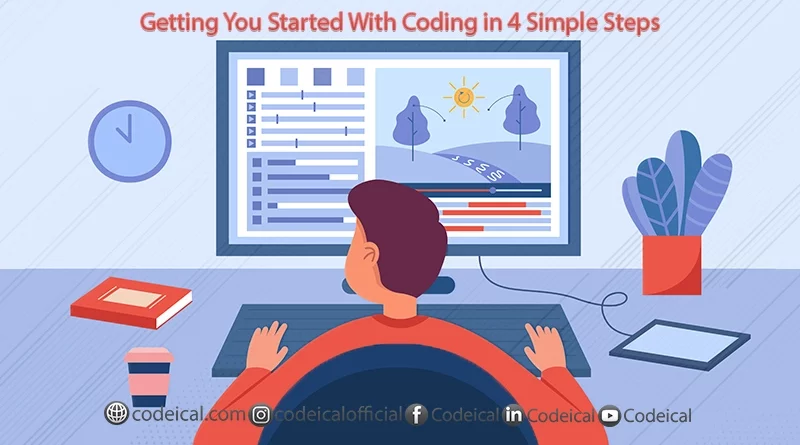Getting You Started with Coding in 4 Simple Steps
Are you eager to delve into the fascinating world of coding and web development? Congratulations on taking the first step towards this exciting journey! In this article, we will explore four essential steps to Getting You Started with Coding . These steps will equip you with a solid foundation, demystifying programming and shedding light on the inner workings of computers. By the time you’ve finished reading this post, you’ll be well-prepared to tackle the next challenge: selecting your inaugural programming language for mastering!
Now, you might be wondering if delving into the depths of computer science is a prerequisite for venturing into the realm of coding. The answer is both yes and no! While you don’t need an extensive computer science background to become a professional developer, having a grasp of its fundamentals can significantly expedite your learning process and make your journey smoother.
To ensure you embark on your coding journey with the utmost confidence, this article aims to cover a broad spectrum of topics. These insights represent valuable knowledge that I wish I had possessed when I commenced my coding and web development endeavors. Understanding these concepts will undoubtedly pave the way for a more seamless and successful experience as you dive into the world of web development.
So, without further ado, let’s begin this exciting journey!
Step #1:
Learn the Basics of Programming
For those who are taking their first steps into the world of coding and computer science, or if you find yourself overwhelmed by the abundance of technical jargon, it’s crucial to begin with the fundamentals.
It’s true; the sheer volume of terminology can be quite daunting, especially for newcomers to the field. Rest assured, you’re not the only one who has felt this way – I’ve been there myself, and it nearly drove me to the brink of frustration.
At the outset, it may appear as if the entirety of coding is an enigma, with none of the terminology making any sense. However, I can assure you that, with time and practice, you will begin to grasp these concepts and develop a solid foundation in the world of coding and computer science.
As you progress on your coding journey, remember that understanding the basics is a crucial first step, and from there, you’ll build your knowledge and expertise.
What is programming exactly?
Okay, let’s delve into some theory here. Computer programming simply involves instructing a computer on what tasks to perform. It’s as straightforward as that.
So, at its core, a computer program consists of a series of individual instructions crafted using code. Each of these instructions corresponds to a specific task that we want the computer to execute on our behalf.
Now, to effectively convey our intentions to the computer, we require a means of communication, right?
This is where programming languages come into play. A programming language is akin to any other language in many ways. It possesses its own set of rules and grammar, not unlike English.
Once you’ve completed the process of writing your program, the next step is to execute it on your computer. If the program is free from bugs or errors, meaning it’s devoid of mistakes, the computer will obediently carry out every instruction contained within it.
The remarkable aspect of computers is their unwavering consistency. They never experience a bad day, they don’t complain about short lunch breaks, nor do they ever fail to show up for work. As long as you supply them with power and your programs are well-written, they faithfully perform their duties without fail.
Who should learn programming?
The question of who the perfect candidate for embarking on the journey of coding might arise frequently. The answer, which might surprise you, is quite simple: anyone and everyone is a potential candidate! That’s right – you, too!
One of the most beautiful aspects of learning coding is that it doesn’t discriminate based on your existing skills or experience. If you possess basic math knowledge and can think logically, you’re on your way to becoming a proficient web developer. You don’t need to be fluent in binary code, and the Fibonacci sequence can remain a mysterious term for now – perhaps even resembling the name of a mouthwatering pizza.
The beauty of coding is that you’ll acquire all the necessary knowledge along the journey. We promise it’s not as daunting as it might seem initially. What truly matters is finding a passion for learning and a commitment to staying motivated and driven. As long as you maintain your enthusiasm, you’re well on your way to a successful coding adventure.
Remember, there are no barriers, and the doors to the world of coding are wide open for you. So, don’t hesitate – take the first step, and you’ll be amazed at what you can achieve.

Step #2:
Understand why computers are so awesome
The remarkable power of computers lies in their extraordinary speed. To put it simply, a computer program consists of a series of instructions, ranging from basic addition to more complex arithmetic operations.
Here’s the key point: a computer can perform thousands of calculations in just one second.
Consider this straightforward example: You and I can both multiply 2 by 2 and then multiply the result by 2 again. If we continue this pattern, continually multiplying the subsequent result by 2 and adding it to our list, we will soon have a lengthy list, something like this:
4, 8, 16, 32, 64, 128, 256, 512, ...
Consider this: if a computer sat beside us, it could effortlessly generate extensive lists with millions of entries before we even touched the keyboard.
Imagine the daunting task of manually sifting through a phone book to find all the numbers ending with 8. It’s a task that might feel more punishing than a prison sentence!
But not for a computer; it would tackle it with ease.
These are merely uncomplicated illustrations, but they underscore an essential point: computers excel at handling repetitive and tedious tasks, such as traversing lengthy lists.
It’s no surprise that most computer programs comprise instructions of this kind; they leverage the computer’s strengths.
In my current journey of learning Python, a substantial portion of the code I’ve written falls into this category. It involves issuing commands to navigate through lists, identify specific elements, and execute prescribed actions on them.
To illustrate, in one exercise, I manually squared the first 5 integers, taking approximately 20 seconds. (I was never particularly skilled at math!) Then, I instructed my computer to perform the same task for the first 1,000 integers, and it accomplished it in a mere 0.4 seconds. (Mic drop!)

Step #3:
Know how computers work
As previously emphasized, understanding the inner workings of computers is crucial when delving into programming.
Considering that, as a professional developer, your code is intended to run on a computer, it’s imperative to comprehend the underlying processes. Without this insight, evaluating the quality and structure of your programs can be challenging.
I can attest to this from personal experience. When I first began my coding journey, I had absolutely no knowledge of computer systems. I was utterly clueless, and the barrage of technical terminology left me feeling overwhelmed to the point of almost giving up.
So, I implore you not to repeat my mistake. To establish a solid foundation in computer understanding, it’s essential to grasp at least the fundamentals of Computer Science.
Fortunately, there are several excellent resources I’d recommend to assist you on this educational path.
There’s a great course available on Udacity called Intro to Computer Science. I encountered some challenging Python questions and decided to take it. Give it a look. (You’ll also gain additional insights into the Fibonacci sequence, by the way.)
Step #4:
Learn the boring stuff, too
I get it, learning Computer Science might not sound like the most thrilling endeavor when all you want is to dive into coding and conquer the world. But hear me out for a moment.
You probably have a crystal-clear vision of what you want to create with your programming skills, and if you’re anything like me, you’re eager to achieve your goals pronto—ideally, today, if not tomorrow.
But then, out of the blue, you find yourself watching a video about how different types of computer memory impact a program’s speed. Yawn! (Where’s that exciting web app tutorial?)
Or perhaps you’re delving into the intricacies of how a web server’s location affects a website’s loading speed. Just hang in there!
Even though you won’t use everything you learn in a Computer Science course in your daily life down the road, it’s still worth the journey. Having a grasp of the fundamental workings inside a computer will prove invaluable, take my word for it. Plus, it will improve your future programming skills and give you insight into how the Internet functions.
Sure, there’s a lot of theory involved. I understand you probably won’t be calculating website loading times based on the speed of light and the web server’s location, or maybe you will, and kudos to you!
Nonetheless, I believe it’s beneficial to explore the history of computers and some technical aspects. It can only enhance our comprehension of the present.
You’ll come across the information and solutions you require in due time. By that point, you might already have a multitude of new inquiries. Simply address them individually with perseverance and resolve. Each solution will propel you forward, one step at a time.
Ready? Let’s get you started with coding!
I trust you’ve discovered valuable tips for preparing yourself to learn programming in this post!
Let me assure you that when I initially ventured into coding, I made a multitude of hasty decisions in my pursuit of rapid results. In doing so, I inadvertently squandered a considerable amount of time.
You see, I was engrossed in coding, but the intricacies of what I was truly doing and the underlying processes when I executed my programs remained elusive to me. This led me to take a substantial step back and return to the fundamentals. I recognized the necessity of grasping, at the very least, the core principles of Computer Science to evolve into a proficient web developer and programmer.
With that in mind, I sincerely hope that you won’t have to tread the same path laden with mistakes as I did. These steps are designed to propel you closer to your coding aspirations.
I’ve shared what I had in mind, and now it’s your turn!
How did your programming journey commence? Have you also encountered crucial lessons along the way? Please share your experiences in the comments below – I’m eager to hear from you!
Postscript: If you found this guide on beginning your coding journey enjoyable and informative, kindly share it with others to help them explore this valuable resource as well. Thank you very much!
Wishing you productive coding ahead,
Codeical!

